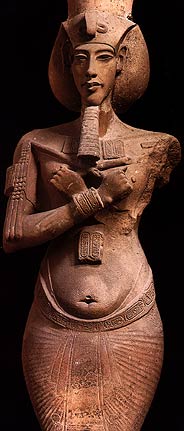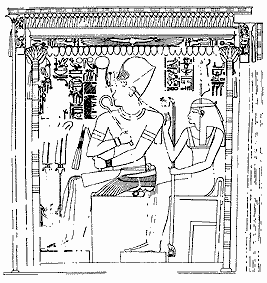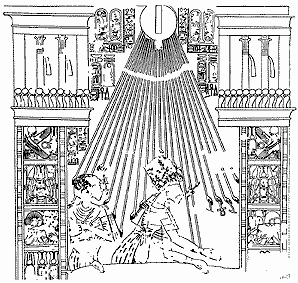|
|
|
 |
 |
Who was Akhenaten? Perhaps one of the most studied, despised, loved figures of ancient Egypt - sometimes thought as a religious zealot (of the Aten sun god) who instigated a new form of art into the stuffy staid ways of ancient Egypt, or a sufferer of a disease wishing to express his body to the world. About Akhenaten there is an air of mystery - why did he chose to worship just one god and banish all others, why did he forgo the traditional look of a warrior - and what happened to him and his cause? The early years The second son of the great Amenhotep III, Akhenaten came from obsurity when his elder brother and heir to the throne, Thuthmose, died while still a child. At this point the young Akhenaten was still known by his original name - Amenhotep (IV), it was only when he ascended the throne that he would change his name. Immediately he took up the offices and teachings of a prince regent, including studying at the centre of intellectual learning for Egypt - Heliopolis. |
 |
|
A Co-Regency It was usual for the heir to the throne at this time to spend several years ruling alongside the outgoing pharaoh, but as the ancient Egyptians did not use a 'standard' calendar it is always difficult to calculate the amount of time a co-regency lasts (the years in ancient Egypt were known as Year 10, Year 11, Year 12 etc - these years referred to the amount of time that a particular pharaoh had ruled, for example a date would be known as Day 27 of month two of Peret (winter) Year 2 under the majesty of King Ramesses). One of the big disagreements between scholars of this period is the length of the co-regency between Amenhotep III and his son Akhenaten, some argue a long co-regency, others a short period, while others are against any co-rengency between the two pharaohs at all. Very little evidence survives to prove it one way or another. Why is this important? If it can be proved that there was no co-regency or only a very short one, then it is a good possibility that the two successors of Akhenaten - Smenkhkare and his brother Tutankhamun are both Akhenaten's own sons. In the city of Akhetaten built during Akhenaten's rule, stone reliefs have been found which show the two pharaohs dining together..... unfortunately this doesn't prove the argument one way or the other, it is possible that Akhenaten was just paying homage to his dead father as was the custom. During his reign, Akhenaten did order the defacement of Amenhotep III's name, to remove the name of the previous (and during his reign illegal) god Amen - surely something that would only have happened after Amenhotep III's death. The First Appearance of Nefertiti and a new Art Style Nefertiti was shown alongside Akhenaten, her husband, on a relief found at Thebes (from the tomb of Ramose - TT55) made during the very earliest part of his reign, in the new unique style of art championed by Akhenaten. Their first daughter was born towards the end of the first year of Akhenaten's reign (Meritaten), to be followed in succession by five sisters (Maketaten, Ankhsenpaaten, Neferneferuaten, Nefernefrure and Stepenre).
The new Sun-God The god whom Akhenaten chose to honour above all others, was a new version of a solar deity, this new god had slowly been gaining favour (mostly among the nobility), but it was under the new reign of Amenhotep IV that the Aten found national prominence (recent thinking is that the Amenhotep III may have been identified as the Aten). At the King's accession the Aten was formally acknowledged as 'Re-Herakhte rejoicing on the horizon in his aspect of the light which is in the sun's disk [the Aten]', although at this point the Aten still took second place behind the all-powerful national god Amun-re of Karnak. Many have argued that the main reason why Akhenaten chose to worship the Aten and no other gods in Egypt, and then to outlaw the worship of these 'older gods' was because that the High Priests of such gods of Amun-Re were too powerful, the High Priest of Amun-Re almost had similar power and influence as that of the Pharaoh himself. But the total revolution that Akhenaten bought to Egypt shows more at work than just politics, for it wasn't just a god that changed, but also art, tombs, the temples to worship the god and even the afterlife. Year 5 of Amenhotep IV - a new name and a new city.
The Fifth Year of Amenhotep IV's reign was a time of many changes, for not only did he decide to change his name to Akhenaten, he found a perfect site along the banks of the Nile where he could be build a new capital of Egypt - Akhetaten. It was on the thirteenth day of the eighth month, the Pharaoh found a plain within a semicircle of cliffs - here he set up an altar and made an offering to the Aten in thanks for leading him to this chosen place. Later at the foundation ceremony of the city, Akhenaten expressed how the city had been revealed to him alone by his father, the Aten, as his chosen seat. The pharaoh stressed that he would build the town in this place and no other. He later said how he would excavate the cliffs surrounding his new city for the site of his own Royal Tomb rather than go back to the Valley of the Kings. The cliffs facing the city were soon filled with the burial chambers of the followers of Akhenaten, from here many of the personalities can be found from the city. |


